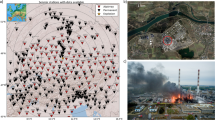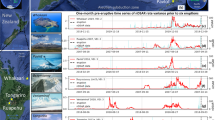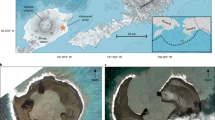Abstract
THE usual way of determining the depth of focus of an earthquake is to measure the difference, τ, between the arrival time of the direct P wave and the arrival time of the surface reflexions pP and sP. pP and sP are the signals that travel upward from the focus as P and S waves respectively are reflected at the free surface above the focus (with conversion of some S energy to P) and then travel steeply downwards (as P waves) passing close to the focus and following a path to the receiving station similar to that of P. Thus τ depends on the difference in path length between P and the surface reflexions (and hence on the depth of focus) and on the velocity structure in the crust and upper mantle above the focus. The depth of focus can be estimated because the velocity structure of the upper mantle is known. This method is difficult to use for determining the depth of firing of underground explosions using P signals with frequencies around 1 Hz: τ is small (often 1 s or less) and the effect of the recording instrument, and of absorption in the Earth's mantle, is to smear out P and pP (sP is not generated by a pure explosion source) so that the two arrivals usually overlap. Here we describe a method of applying corrections for absorption and recording instrument effects to the P signals recorded from explosions so that P and pP can be more easily identified as separate pulses and their difference in arrival time measured. Then for explosion signals recorded at long range  where d is the depth of firing and v the velocity in the overburden.
where d is the depth of firing and v the velocity in the overburden.
This is a preview of subscription content, access via your institution
Access options
Subscribe to this journal
Receive 51 print issues and online access
$199.00 per year
only $3.90 per issue
Buy this article
- Purchase on Springer Link
- Instant access to full article PDF
Prices may be subject to local taxes which are calculated during checkout
Similar content being viewed by others
References
Carpenter, E. W., and Flinn, E. A., Nature, 207, 745 (1965).
Futterman, W. I., J. Geophys. Res., 67, 5279 (1962).
Carpenter, E. W., Absorption of Elastic Waves—an Operator for a Constant Q Mechanism, AWRE Report No. 043/66 (HMSO, 1966).
Robinson, E. A., Statistical Communication and Detection with Special Reference to Digital Data Processing of Radar and Seismic Signals (Griffin, London, 1967).
Robinson, E. A., Geophysical Prospecting, 14, Appendix 1 (1966).
Practical Aspects of Applications of Contained Peaceful Nuclear Explosions for Industrial Purposes (trans. by Jones, W. E.), AWRE Trans. No. 63 (HMSO, 1971).
Seismic Data Laboratory Report No. 133 (Defence Documentation Center, Cameron Station, Alexandria, Virginia, 1965).
Preliminary Determination of Epicentre Card 64–69 (US Coast and Geodetic Survey, 1969).
Lambert, D. G., Von Seggern, D. H., Alexander, S. S., and Galat, G. A., The LONGSHOT Experiment, 2 (Seismic Data Laboratory, Alexandria, Virginia, 1970).
Julian, B. R., and Davies, D., Semiannual Technical Summary (Lincoln Laboratory, Massachusetts, June 1971).
Marshall, P. D., Douglas, A., and Hudson, J. A., Nature, 234, 8 (1971).
Author information
Authors and Affiliations
Rights and permissions
About this article
Cite this article
DOUGLAS, A., CORBISHLEY, D., BLAMEY, C. et al. Estimating the Firing Depth of Underground Explosions. Nature 237, 26–28 (1972). https://doi.org/10.1038/237026a0
Received:
Issue Date:
DOI: https://doi.org/10.1038/237026a0
This article is cited by
-
Depth Calculation for the January 06, 2016, the September 09, 2016 and the September 03, 2017 Nuclear Tests of North Korea from Detailed Depth Phases Using Regional and Teleseismic Arrays
Pure and Applied Geophysics (2019)
-
Distinct sites of action of clostridial neurotoxins revealed by double-poisoning of mouse motor nerve terminals
Pflügers Archiv - European Journal of Physiology (1987)
-
Transmitter release in tetanus and botulinum A toxin-poisoned mammalian motor endplates and its dependence on nerve stimulation and temperature
Pfl�gers Archiv European Journal of Physiology (1983)
Comments
By submitting a comment you agree to abide by our Terms and Community Guidelines. If you find something abusive or that does not comply with our terms or guidelines please flag it as inappropriate.



